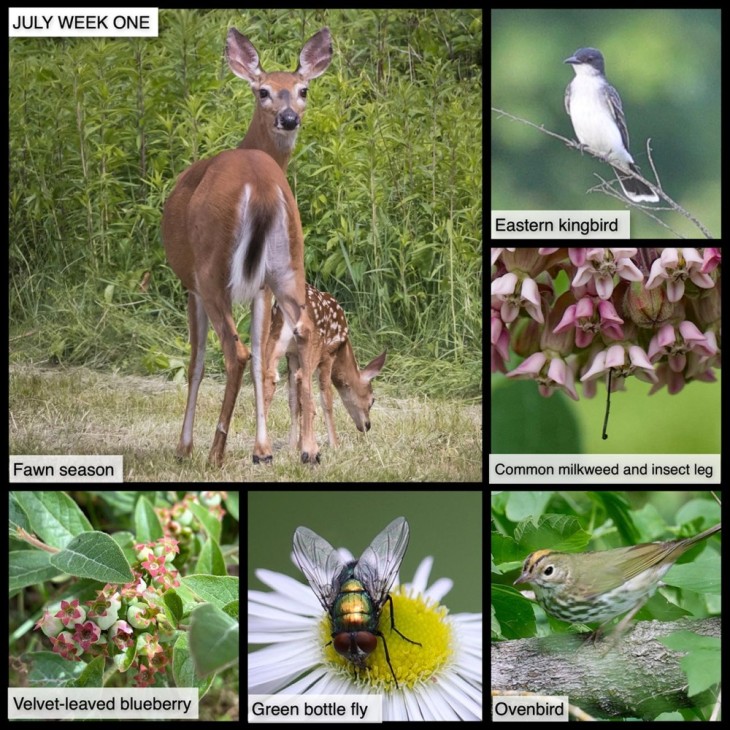This Week in the Woods, some young fawns of white-tailed deer are still tucked in their hiding places, although earlier-born ones have started feeding on plants and may be easier to see. As Susan Shea notes in this Outside Story essay, newborn fawns have almost no scent, and one of the ways that their mothers keep them safe is by staying at a distance except when they’re actively nursing. Fawns are remarkably good at blending into their surroundings, but you may stumble into one while walking through tall grass or, as in one friend’s recent experience, weeding a flower garden.
Here are some other nature sights this week (clockwise):
What’s the difference between a T. rex and an eastern kingbird? For starters, the T. rex only has one Tyrannus in its Latin name (that wimp). Eastern kingbirds, Tyrannus tyrannus, are fierce protectors of their nesting territory; we’ve watched a pair chase off a great horned owl, and during this pursuit, one of the kingbirds actually pecked the owl’s back. You’re most likely to find this species hunting along a hedgerow or other site with a combination of trees and buggy meadow. They’re fun to watch; kingbirds are salliers, meaning that (in common with flycatchers) they hunt flying insects by swooping out from a tree branch or other perch, nabbing their prey, and then returning to their perch to eat. Here’s a profile from The Cornell Lab’s All About Birds website.
This photo shows the dark side of common milkweed. Milkweed plays an essential role as the host for monarch butterflies, and its umbels of fragrant pink blooms nurture numerous other pollinators. However, if you look at the bottom of this image, you’ll see what looks like a tiny stick hanging from one of the flowers. That’s a leg. As Kent McFarland notes in this post for the Vermont Center for Ecostudies, milkweed flowers have tiny slits between their pink hoods, and each contain two pollinia – packets of pollen that stick to insect legs. The best case for the flower is for the insect to step in the slit, thrash around a bit, get the pollinia stuck to its leg, and then escape intact to visit another milkweed flower. But accidents happen. Now that you know about these leghold traps, you’ll notice disembodied legs – and dead insects dangling by their legs – almost every time you look at milkweed blooms. You’re welcome.
We found this ovenbird foraging near a fern patch (perhaps the location of its nest) not far from the Northern Woodlands office. This common woods bird gets its name from the shape of its nest, which this Audubon profile describes as, “a domed structure with the entrance on the side, like an old-fashioned oven.” The bird is easy to miss as it scuttles from log to brush pile, but its blaring “teacher teacher teacher” call is a classic sound of the summer woods. Both male and female ovenbirds have a distinctive orange stripe on the head. However, they rarely stay still long enough for close inspection, and the stripe can be hard to discern in the deep shade of trees.
Iridescent green bottle flies are beautiful as they nectar on summer flowers. They are not so beautiful when, say, they’re in the act of laying their eggs on decaying carrion, but (brace yourself) it turns out that their maggots, described in this article as “the world’s smallest surgeons,” can be remarkably effective as a treatment for wounds infected with antibiotic-resistant MRSA bacteria. Moving on before we think too much about the details of that....
Summer berry season is starting up. Assistant editor Meghan McCarthy McPhaul took this image of still-green velvet-leaved blueberries in a field in the White Mountains. As noted in this profile from The Native Plant Trust, velvet-leaved blueberries tend to grow at higher elevations, but there are several native species in our region, all popular with wildlife as well as people.
Our thanks to The Bailey Charitable Foundation and the Frank and Brinna Sands Foundation for helping to support this series.
In this difficult period, many of us find joy in observing local nature. This series, launched in April 2020, shares nature photographs taken in the past seven days, or in the same week in 2020, most within 15 miles of the Northern Woodlands office in Lyme, New Hampshire. We hope you enjoy using this grid as a prompt for your own explorations.
What are you seeing in the woods this week? Share your images with us on Facebook, or submit a special photo for possible inclusion in our monthly online Reader Photo Gallery.


